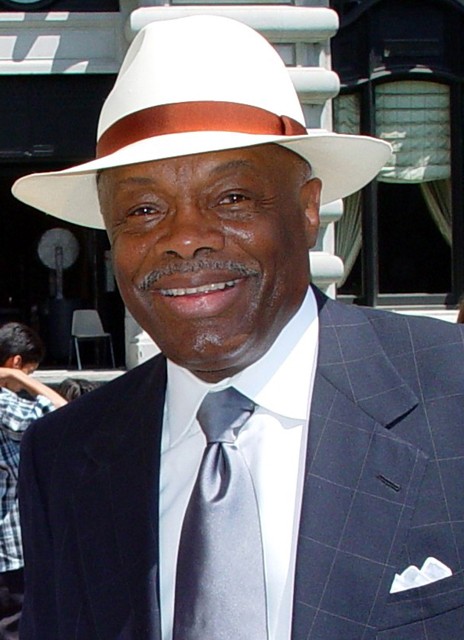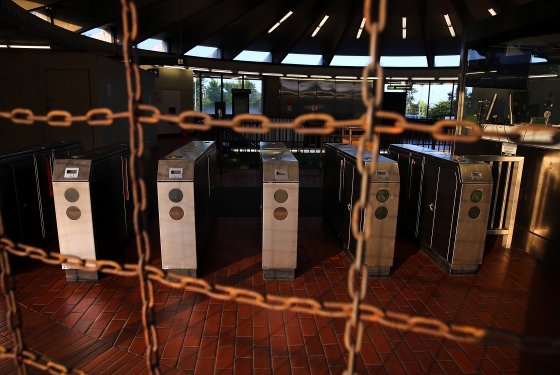
The Senate violated their own rules on renaming structures after living people, so they could name it after a politician that did nothing for the bridge, instead of naming it after the man who first proposed he bridge.
the monkeys know all

The Senate violated their own rules on renaming structures after living people, so they could name it after a politician that did nothing for the bridge, instead of naming it after the man who first proposed he bridge.

BART Strike Shows Privatization’s Dark Side:
Just compare these two reactions to the BART strike. One is from an executive of a ride-share company called Avego, which allows drivers to open up their cars (for a fee) to strangers looking for a lift:
“All you need to do is book a trip from San Francisco to wherever you’re going home for tonight or every day this week there’s a strike,” Paul Steinberg, director of Americas for Avego, said in an interview on “Bloomberg West.”
And another is from a working-class Oakland resident who uses BART to get to work every day:
Ilysha Kipnis of Oakland expected limited BART service, not zero service. Because buses and ferries were jammed, she decided to take a bus back home to wait out the traffic.
“We’re so reliant on public transportation,” said Kipnis, who works at a salon in San Francisco. “Hopefully, (BART directors) understand how much we need the trains to run. … I really need it.”
Notice the split here. The tech executive assumes that people who are stranded by BART can simply arrange for an alternative way of getting to their destination. (Incidentally, his company is also the one running a helicopters-for-commuters promotion to take advantage of the BART strike.) But the Oakland resident doesn’t work at Google or Facebook, where free shuttle service is provided, and she can’t easily get herself around by car. For the tech executive, a BART strike is an annoyance. For the salon worker, it’s a threat to basic existence.

Keha3‘s Pavel Sidorenko, Tarmo Luisk, Margus Triibmann collborated on this led streetlight concept for LED Street. What I like about the design is how thin it is, while still looking like a modern streetlamp. What would normally be a reflector, is hinged rain cover to allow access to the lighting elements. According the LED Street site, the lighting element is replaceable and comes with different numbers of lighting strips in order to customize illumination and power usage.

The winner of this year’s James Dyson Award, Edward Linnacre’s Airdrop is a device that extracts water from air for use as in irrigation. If this sounds, like a Tatooine moisture farm, it should. However, unlike Uncle Owen’s GX-8 water vaporator, the Airdrop doesn’t use refrigerant, but rather the temperature differential from air to soil.
The Airdrop consists of a small reservoir buried about two meters in soil. Rising out of the tank and up to the surface is a cylinder containing a copper coil filled with copper ball bearings used in home distilleries. The copper tubing continues up to a turbine like those used on attic vents, but with the vanes turned around so that air is driven into the tubing instead of out of it. Also in cylinder is a submersible pump that transfers water from the tank to a drip irrigation line. The pump is controlled by an embedded microcontroller and solar powered. In times of little wind, the turbine can be powered by an electric motor.

New Scientist links to the European Commission’s Joint Research Centre’s Global Urbanisation and Accessibility Map – part of the World Bank’s 2009 World Development Report. The maps is made by plotting the estimated travel time to a “major” city. They conclude that only 10% of the world is more than 48 hours from a city. Primarily the most remote places are the poles, southern Venezuela, and central Tibet. Even the Sahara is comparatively more accessible.

Song Youzhou showed off his design for bus that allows traffic to pass underneath, at last May’s Beijing International High-tech Expo. The idea is passengers would board the bus at elevated stations, without interrupting traffic flow. Song proposes that streets be modified to either have rails for the bus to ride on (effectively turning it into a tram), or installing an optical guidance system (probably similar tot he one installed on some TEOR buses.) to aid in driving.
Song claims that Beijing’s Mentougou District (a Beijing suburb) will adapt 186 km of roads for the bus, beginning at the end of this year.
When I first saw the picture for this, I though that passengers would board at street level perhaps through either a stairwell mounted in the legs, or maybe retractable stairs. An elevating platform would available for wheelchair access. I’m kind of disappointed that this design requires elevated platforms, but it probably for the best. What will be interesting will be to see how drivers react to encountering one of these busses. The use of special traffic lights for cars under the bus, is a good idea.
It will be interesting to see if this is actually built, and if it is is widely adopted.
Jianjun Chen in China proposed an interesting idea for eliminating station dwell times for trains. In his/her design, each train has a detachable boarding shuttle mounted on the roof of the train. Passengers who wish to disembark leave the main passenger compartment of the train, and enter the shuttle. Meanwhile, embarking passengers board an identical shuttle already located at the station. As the train approaches, the shuttle mounted on the train, disengages so it can slow to a stop at the station, while the shuttle is grabbed and mounted onto the moving train.
By using a separate boarding shuttle, passengers can board and unboard at their leisure, while transiting passengers can continue on their journey. By eliminating dwell time, passenger throughput can be increased, and travel times diminished. Chen calculates that such a system would would decrease the travel time between Beijing and Guangzhou from an estimated 8 hours to approximately five and a half, if five minute stops on all 30 intermediate stations were eliminated.
via Machine Thinking